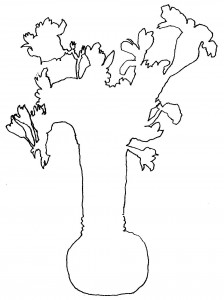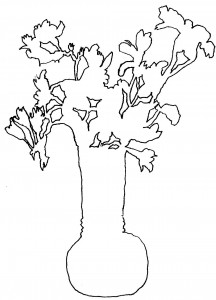I miss teaching art so let’s pretend that you’re in my 10th grade drawing class. Today’s lesson is about seeing objects in a different way. Objects do not have black lines around them to show their contours, but we’ll pretend that they do.
Lines, outlines, and curves become shapes that represent objects. When demonstrating this with a pen it is called contour drawing. Let’s try it together.
Materials: black marker like a Sharpie with a fine point and a brown paper grocery bag.
#1) How to “see” the outside contour without drawing:
Place the object you’ve chosen to draw about five feet away on a table. It could be a potted plant, kitchen utensils, scissors sticking out of a container, a chair, etc.,
Practice Seeing:
Start looking wherever you want but pick a point on the outside edge of your object. Let your eyes travel slowly around the edge of the object. Go slow, but keep your eyes moving ’til you get all around the outside edge and end back where you started.  #1 Practicing seeing the outside contour of an object
#1 Practicing seeing the outside contour of an object
Practice Seeing while Drawing (Blind drawing):
Now, put your pen in hand and your hand inside the open bag so you can’t see what you’re drawing. Pick a point on the outside edge again and pretend your eyes are glued to the tip of the pen and you’re traveling around the edge with your “eye-pen.” Do NOT lift your eye-pen from the paper but do keep traveling slowly all around the outside edge of the object as you draw the imaginary line that is the outside contour. With any luck your line might actually match up with the line that you started. Now, cut open your paper bag so it will lay flat and have a look at your drawing. It will look sort of odd but it takes on a new and curious life. The resulting shape is called a contour. #1 Blind Drawing – inside of a paper grocery bag.
#1 Blind Drawing – inside of a paper grocery bag.
I like blind drawings because they’re funky but interesting. Now, stop admiring YOUR blind drawing and do the same thing on a clean sheet of paper or on another paper bag cut open so it can stay flat and go to #2.
#2 Drawing the contour while LOOKING at the object and LOOKING at your drawing.
This time your eyes and hands are still working together but you can see what you’re doing. Bounce your eyes back and forth between the object and your drawing so you can keep the lines sort of where they belong. But still go slow as you travel around the outside edge of the object with your “eye-pen.” If you speed around the edge, the drawing will look rushed and too smooth and you won’t get a decent grade in this class. Pay close attention to every change in the direction of the line. Don’t rush and don’t miss a single bump or set of wiggly lines. Just keep looking back and forth at the object and at your drawing. Don’t worry if your line goes astray. That’s part of the charm of contour drawing. Just keep traveling all the way around the outside contour of the object and don’t miss any of the detours. Enjoy the trip to the end. With any luck you’ll end up where you started. However, if your line doesn’t match the original line just fake it. Create a new line and introduce it to the old one. Trust me. They’ll be only too happy to meet. The outside contour has now created an enclosed shape that is the same as a silhouette or shadow picture. Admire it for a few seconds and then move on to #3.
 #2 Drawing while LOOKING at the outside contour of an object
#2 Drawing while LOOKING at the outside contour of an object
#3) NOW, let’s get serious about looking for inside shapes or empty spaces inside of this silhouette. There are many. If you’re drawing a chair or kitchen gadgets sticking out of a container, there might be a lot of inside shapes (empty spaces). They may SEEM like empty spaces but think of those “holes” as shapes or inside contours. The shape of empty space is called “negative space” or “negative shape.” Most people refer to it as the “background.” Background (empty space) is as important as the object you’re drawing. The shape of the background space works with the shape of the object to create an image that uses the space well.
Think of the positive and negative shape-spaces as a married couple. One partner is more noticed and outspoken and the other doesn’t mind a partner that hogs the limelight because love and admiration for each other holds them together.
Negative space (the shape of empty space) is as important as the object you’re drawing. The shape of the object that you’re drawing is called a “positive space” or “positive shape.” Don’t miss any and try to include them all; both positive and negative shapes.
 #3 Adding the INSIDE shapes (empty spaces)
#3 Adding the INSIDE shapes (empty spaces)
Isn’t this nifty? It’s coming to life.
Okay, okay…let’s move on to #4
#4) This is the time to look for any other lines or shapes that will liven your drawing and give it some “bling.” Do some more “seeing” and add any details you might’ve missed that are INSIDE of all shapes. It’s like putting on your makeup, jewelry, cologne, after shave, hanky in the pocket, name tag, etc. There are more steps you can do on your own without me here such as adding different shades of gray, adding color, texture, pattern or whatever sounds like fun.
BUT, if f you leave the image as is with no more bling, the end result is called a LINE DRAWING. . Ta dah!
 This is a line drawing by me, Betty Auchard
This is a line drawing by me, Betty Auchard
-
oscar case













